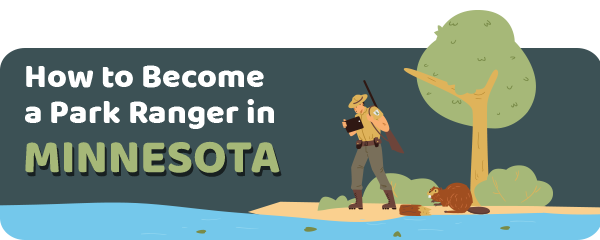
With over 60 state parks in Minnesota, you’ll find that there are plenty of opportunities for recreation.
If you love spending time outdoors, becoming a park ranger may be the perfect career path.
You can participate in hikes, lectures, and so much more.
Getting started is even easier than you might think.
Earn your accredited, affordable Wildlife Forestry and Conservation career diploma online with Penn Foster in as little as 4 months!
Article Table of Contents
Popular Programs
Requirements to Become a Park Ranger in Minnesota
There are not a lot of requirements to become a park ranger in Minnesota.
It is focused on education, state residency, and ensuring that you follow all of the guidelines when applying to an open position in the state.
When you decide you want to be a park ranger, you’ll want to get a bachelor’s degree in a field that will be of use.
This can include botany, zoology, or any of the life sciences.
You can also get a degree in public administration, criminology, and more.
Positions are listed within the Minnesota Department of Natural Resources.
You’ll need to provide a valid driver’s license within the state to prove that you are a resident.
You’ll also need to submit a background check to show that you have no convicted felonies on your record.
Park Ranger Duties in Minnesota
The duties of a park ranger in Minnesota will vary based on the size of the park and the activities that are available.
You will be responsible for overseeing public safety and responding to emergencies.
Additionally, you will work with other agencies when responding to environmental emergencies as well as any criminal activities.
The parks are often free, so you will also be working with visitors to provide tours, and lectures, and oversee special events throughout the year.
Many of the state parks in Minnesota also host managed hunts as a way to manage the deer population.
Park rangers will be overseeing the hunts and ensuring that all hunters practice safety in the woods.
Some of the parks will close or adjust their offerings based on the season.
As a park ranger, you would be responsible for deciding what activities would need to be closed.
State Parks in Minnesota
You’ll find a wide array of state parks and recreation areas throughout Minnesota, many of which feature activities that will keep you busy for days at a time.
Bear Head Lake State Park: Located in Ely, the park offers 23 miles of lakeshore.
There’s a significant wilderness atmosphere and offers some great hiking trails.
You’ll see quite a bit of wildlife while you’re in the park, which is another reason to be careful when participating in camping or other activities.
Lake Carlos State Park: Located in Carlos, the park offers fishing on a Chain of Lakes as well as hiking through Rolling Hills.
Water recreation comes in the form of swimming and boating.
Birdwatching is another popular activity at the state park.
Monson Lake State Park: Located in Sunburg, the park is one of the smaller ones in the state.
It is situated on the water, offering a significant amount of fishing and boating opportunities.
It is also possible to go camping, and nearby Sibley State Park offers additional supplies as needed.
Gooseberry Falls State Park: Located in Two Harbors, the state park offers scenic waterfalls and sits on some of the shorelines of Lake Superior.
There are various log and stone structures of historic importance and a visitor center with a large nature store.
Zippel Bay State Park: Located in Williams, the state park is located on the beach.
There is a marina and boat launch, a fishing pier, and an array of hiking trails.
There’s also winter recreation in the colder months.
Salary
The salary for park rangers in Minnesota can vary, with a typical range being between $36,166 and $52,939 according to Salary.com.
The average park ranger in Minneapolis will earn an annual salary of $43,752.
Your compensation will depend heavily on the years of experience you have, your special skills, and even your education.
Annual Salary Range:| Location | Avg. Annual Salary |
|---|---|
| Burnsville | $43,628 |
| Duluth | $38,951 |
| Eden Prairie | $43,678 |
| Lakeville | $43,481 |
| Minneapolis | $43,752 |
| Minnetonka | $43,752 |
| Rochester | $39,772 |
| Saint Cloud | $38,976 |
| Saint Paul | $43,752 |
| Angora | $38,581 |
Regional Salary in Minnesota
| Region | Employed | Avg. Annual Salary | Avg. Hourly Pay | Top 10% Annual Salary | Bottom 10% Annual Salary |
|---|---|---|---|---|---|
| Duluth, MN-WI | 50 | $75,430 | $36.26 | $100,530 | $52,110 |
| Minneapolis-St. Paul-Bloomington, MN-WI | 280 | $114,590 | $55.09 | $# | $57,410 |
* Employment conditions in your area may vary.
Frequently Asked Questions
What are some of the other career options in the state parks?
If you are looking to work your way up to park ranger, there are various other positions to explore including park maintenance, naturalist, park police officer, and recreation director.
Are the state parks open in the winter?
Although Minnesota winters can be harsh, many stay open year-round.
There are snowy trails, sledding, and even winter camping that takes place in many of the state parks.
What is the largest state park in Minnesota?
The largest state park in Minnesota is St. Croix State Park, which covers 34,000 acres in the east-central part of the state.
Is there a minimum age to work as a park ranger?
The state requires you to be at least 18.
However, if you want to be a park ranger with the National Park Service, you will have to be at least 21.
Are there any special licenses?
There are no special licenses to obtain when you’re a park ranger.
Instead, focus on skills and experience.
Read the full guide: How to Become a Wildlife Conservationist